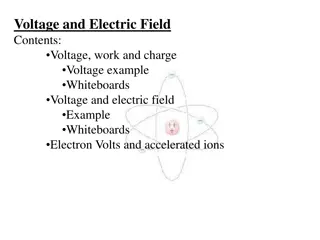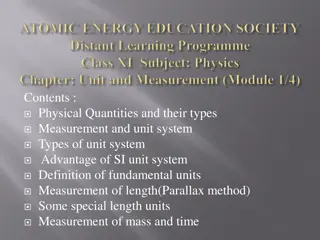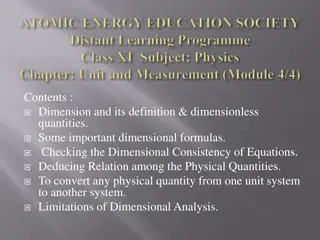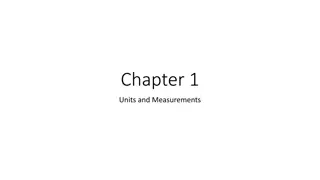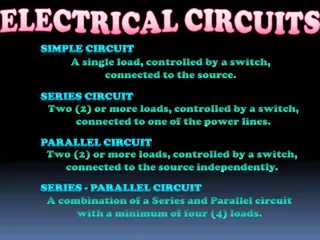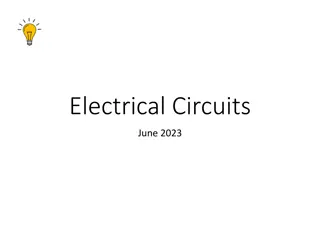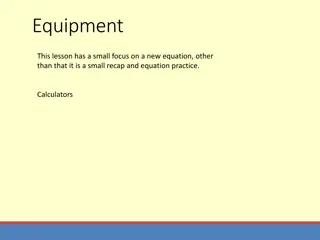Understanding Electrical Quantities and Circuits in Physics
Explore the concepts of electrical quantities such as e.m.f., potential difference, resistance, current, and voltage in circuits. Learn about using voltmeters, measuring resistance, transferring energy in circuits, and understanding the relationships between these electrical properties. Delve into experiments, equations, and characteristics of components like ohmic resistors and filament lamps.
Download Presentation

Please find below an Image/Link to download the presentation.
The content on the website is provided AS IS for your information and personal use only. It may not be sold, licensed, or shared on other websites without obtaining consent from the author. Download presentation by click this link. If you encounter any issues during the download, it is possible that the publisher has removed the file from their server.
E N D
Presentation Transcript
LEARNING OBJECTIVES Core State that the e.m.f. of an electrical source of energy is measured in volts State that the potential difference (p.d.) across a circuit component is measured in volts Use and describe the use of a voltmeter, both analogue and digital State that resistance = p.d. / current and understand qualitatively how changes in p.d. or resistance affect current Recall and use the equation R = V / I Describe an experiment to determine resistance using a voltmeter and an ammeter Relate (without calculation) the resistance of a wire to its length and to its diameter Understand that electric circuits transfer energy from the battery or power source to the circuit components then into the surroundings Supplement Show understanding that e.m.f. is defined in terms of energy supplied by a source in driving charge round a complete circuit Recall that 1 V is equivalent to 1 J / C Sketch and explain the current-voltage characteristic of an ohmic resistor and a filament lamp Recall and use quantitatively the proportionality between resistance and length, and the inverse proportionality between resistance and cross-sectional area of a wire Recall and use the equations P = IV and E = IVt
Recap Current is the rate of flow of electrons around a circuit. The higher the current, the faster the electrons are travelling. The unit of current is the amp, and in a circuit an ammeter is used to measure current. emf
Recap Current is the rate of flow of electrons around a circuit. The higher the current, the faster the electrons are travelling. The unit of current is the amp, and in a circuit an ammeter is used to measure current. emf VOLTAGE is the amount of energy given to electrons as they travel around the circuit.
Recap Current is the rate of flow of electrons around a circuit. The higher the current, the faster the electrons are travelling. The unit of current is the amp, and in a circuit an ammeter is used to measure current. emf VOLTAGE is the amount of energy given to electrons as they travel around the circuit. Voltage is also known as POTENTIAL DIFERENCE (PD)
Recap Current is the rate of flow of electrons around a circuit. The higher the current, the faster the electrons are travelling. The unit of current is the amp, and in a circuit an ammeter is used to measure current. emf VOLTAGE is the amount of energy given to electrons as they travel around the circuit. Unit of voltage or PD is the volt. Supplement 1 volt = 1 joule of potential energy is given to each coulomb of charge (1J = 1 J/C) Voltage is also known as POTENTIAL DIFERENCE (PD)
VOLTAGE is the amount of energy given to electrons as they travel around the circuit. emf Voltage is also known as POTENTIAL DIFERENCE (PD) The cell produces its highest potential difference when not connected in a circuit. This maximum PD is known as the electromotive force (EMF) of the cell. The battery cell gives electrons potential energy. This energy is then passed on to the components in the cell
VOLTAGE is the amount of energy given to electrons as they travel around the circuit. emf Voltage is also known as POTENTIAL DIFERENCE (PD) The cell produces its highest potential difference when not connected in a circuit. This maximum PD is known as the electromotive force (EMF) of the cell. As soon as the cell is connected in a circuit the potential difference drops because of energy wastage inside the cell. The battery cell gives electrons potential energy. This energy is then passed on to the components in the cell
VOLTAGE is the amount of energy given to electrons as they travel around the circuit. Just a reminder A single cell Voltage is also known as POTENTIAL DIFERENCE (PD) A battery, made up of several cells. A battery is a series of joined cells, although it is commonly used for a single cell as well. The cell produces its highest potential difference when not connected in a circuit. This maximum PD is known as the electromotive force (EMF) of the cell. As soon as the cell is connected in a circuit the potential difference drops because of energy wastage inside the cell. The battery cell gives electrons potential energy. This energy is then passed on to the components in the cell
Voltage is measured using a VOLTMETER Measuring voltage (PD) in a circuit.
Voltage is measured using a VOLTMETER Measuring voltage (PD) in a circuit. To measure the voltage across a component in a circuit the voltmeter must be placed in parallel with it.
Voltage is measured using a VOLTMETER Measuring voltage (PD) in a circuit. To measure the voltage across a component in a circuit the voltmeter must be placed in parallel with it.
Voltage is measured using a VOLTMETER Measuring voltage (PD) in a circuit. Series and parallel circuits In a series circuit the total voltage (PD) of the supply is shared between the various components, so the voltages around a series circuit always add up to equal the source voltage.
Voltage is measured using a VOLTMETER Measuring voltage (PD) in a circuit. Series and parallel circuits In a parallel circuit all components get the full source voltage, so the voltage is the same across all components In a series circuit the total voltage (PD) of the supply is shared between the various components, so the voltages around a series circuit always add up to equal the source voltage.
Whenever a current flows around an electrical circuit there is resistance to the electrons.
Whenever a current flows around an electrical circuit there is resistance to the electrons. Copper connecting wire is a good conductor, it offers little resistance to the electrons, and a current passes through it easily. Nichrome is not such a good conductor, it has a bigger resistance to the electrons, and less current will flow.
Whenever a current flows around an electrical circuit there is resistance to the electrons. Resistance is calculated using this equation: resistance = voltage current I R = V Copper connecting wire is a good conductor, it offers little resistance to the electrons, and a current passes through it easily. Nichrome is not such a good conductor, it has a bigger resistance to the electrons, and less current will flow. The unit of resistance is the ohm (Greek letter omega)
Whenever a current flows around an electrical circuit there is resistance to the electrons. Resistance is calculated using this equation: resistance = voltage current I R = V Copper connecting wire is a good conductor, it offers little resistance to the electrons, and a current passes through it easily. Nichrome is not such a good conductor, it has a bigger resistance to the electrons, and less current will flow. The unit of resistance is the ohm (Greek letter omega) eg. If a PD of 8V is needed to make a current of 4A flow through a wire. Resistance = 8 / 4 = 2
Remember, remember .. The equation linking V, I and R V = I x R V I = V / R I R R = V / I
Factors affecting resistance.
Length of wire Factors affecting resistance. Factors affecting resistance Cross sectional area Temperature Material
Length of wire Factors affecting resistance. Factors affecting resistance Cross sectional area Temperature Material For metal conductors, resistance increases with temperature. For semi-conductors, it decreases with temperature.
Length of wire Factors affecting resistance. Factors affecting resistance Cross sectional area Temperature Material For metal conductors, resistance increases with temperature. For semi-conductors, it decreases with temperature. When a current flows through a wire, resistance causes a heating effect. This principle is used in heating elements and in filament light bulbs.
Length of wire Factors affecting resistance. Factors affecting resistance Cross sectional area Temperature Material Electrons collide with atoms as they pass through conductors, losing energy. The atoms vibrate more, causing a heating effect For metal conductors, resistance increases with temperature. For semi-conductors, it decreases with temperature. When a current flows through a wire, resistance causes a heating effect. This principle is used in heating elements and in filament light bulbs.
Temperature Factors affecting resistance. Factors affecting resistance Cross sectional area Length of wire Material Wires A and B have the same cross- sectional area and are at the same temperature. Wire B is twice as long as wire A, and has twice the resistance. A B
Temperature Factors affecting resistance. Factors affecting resistance Cross sectional area Length of wire Material Wires A and B have the same cross- sectional area and are at the same temperature. Wire B is twice as long as wire A, and has twice the resistance. A B Resistance length Resistance is directly proportional to length
Temperature Factors affecting resistance. Factors affecting resistance Cross sectional area Length of wire Material Wires A and B have the same length and are at the same temperature. Wire B is twice the cross-sectional area of A, and has half the resistance. A B
Temperature Factors affecting resistance. Factors affecting resistance Cross sectional area Length of wire Material Wires A and B have the same length and are at the same temperature. Wire B is twice the cross-sectional area of A, and has half the resistance. A B Resistance 1 area (area = cross-sectional area)
Temperature Factors affecting resistance. Factors affecting resistance Length of wire Material Cross sectional area Some wires have much more resistance for a given length. For example a 10cm length of nichrome has a much higher resistance than copper of the same length and cross-sectional area. Nichrome is said to have a higher resistivity.
Temperature Factors affecting resistance. Factors affecting resistance Length of wire Material Cross sectional area Some wires have much more resistance for a given length. For example a 10cm length of nichrome has a much higher resistance than copper of the same length and cross-sectional area. Nichrome is said to have a higher resistivity. Typical resistivity ( /m) 49 x 10-8 Constantan 44 x 10-8 Manganin 100 x 10-8 Nichrome 55 x 10-8 Tungsten The Greek letter rho ( ) is the resistivity constant for any given material)
Length of wire Factors affecting resistance. Factors affecting resistance Cross sectional area Temperature Material Combining the resistance equations
Length of wire Factors affecting resistance. Factors affecting resistance Cross sectional area Temperature Material Combining the resistance equations Resistance length area
Length of wire Factors affecting resistance. Factors affecting resistance Cross sectional area Temperature Material Combining the resistance equations R = x l A Resistance length area
Length of wire Factors affecting resistance. Factors affecting resistance Cross sectional area Temperature Material Combining the resistance equations R = x l A = R x A l Resistance length area
Length of wire Factors affecting resistance. Factors affecting resistance Cross sectional area Temperature Material Combining the resistance equations R = x l A Comparing different wires, A and B, made from the same material (so is the same for each wire) at the same temperature. = R x A l
Length of wire Factors affecting resistance. Factors affecting resistance Cross sectional area Temperature Material Combining the resistance equations R = x l A Comparing different wires, A and B, made from the same material (so is the same for each wire) at the same temperature. = R x A l ResistanceAx AreaA= ResistanceBx AreaB LengthA LengthB
More about resistors 1 kilohm (k ) = 1000 1 megohm (M ) = 1 000 000 Resistor
More about resistors 1 kilohm (k ) = 1000 1 megohm (M ) = 1 000 000 Resistor Variable resistor Used for varying current, for example in light dimmer switches
More about resistors 1 kilohm (k ) = 1000 1 megohm (M ) = 1 000 000 Resistor Variable resistor Used for varying current, for example in light dimmer switches High resistance when cold, but much lower resistance when hot. Eg. Digital thermometer Thermistor
More about resistors 1 kilohm (k ) = 1000 1 megohm (M ) = 1 000 000 Resistor Variable resistor Used for varying current, for example in light dimmer switches High resistance when cold, but much lower resistance when hot. Eg. Digital thermometer High resistance in the dark but a low resistance in the light. Eg. Controlling light switches Thermistor Light dependent resistor (LDR)
More about resistors 1 kilohm (k ) = 1000 1 megohm (M ) = 1 000 000 Resistor Variable resistor Used for varying current, for example in light dimmer switches High resistance when cold, but much lower resistance when hot. Eg. Digital thermometer High resistance in the dark but a low resistance in the light. Eg. Controlling light switches Extremely high resistance in one direction, but low in the other. Controls flow of current Thermistor Light dependent resistor (LDR) Diode
Ohms Law A 19th Century scientist who first investigated the electrical properties of wires, and the relationship between V, I and R I (the symbol for current) = intensite du courant
Ohms Law How current varies with voltage (PD) for a metal conductor. Circuit diagram: battery Variable resistor Ammeter A Voltmeter V Water bath to keep nichrome at constant temperature Nichrome wire
Ohms Law How current varies with voltage (PD) for a metal conductor. Circuit diagram: battery V I R = V/I 5.0 2.0V 0.4A 4.0 0.8 5.0 Variable resistor Ammeter 6.0 1.2 5.0 A Voltmeter 8.0 1.6 5.0 V 10.0 2.0 5.0 Water bath to keep nichrome at constant temperature Nichrome wire
Ohms Law How current varies with voltage (PD) for a metal conductor. Circuit diagram: battery V I R = V/I 5.0 2.0V 0.4A 4.0 0.8 5.0 Variable resistor Ammeter 6.0 1.2 5.0 A Voltmeter 8.0 1.6 5.0 V 10.0 2.0 5.0 2.0 Current (A) Water bath to keep nichrome at constant temperature Nichrome wire 0 10.0 Voltage (V)
Ohms Law 1. A graph of current against voltage is a straight line through the origin. 2. If the voltage doubles then the current doubles, etc 3. In this experiment, V/I always has the same value.
Ohms Law 1. A graph of current against voltage is a straight line through the origin. 2. If the voltage doubles then the current doubles, etc 3. In this experiment, V/I always has the same value. Current is proportional to the voltage. Current Voltage
Ohms Law Provided temperature is constant 1. A graph of current against voltage is a straight line through the origin. 2. If the voltage doubles then the current doubles, etc 3. In this experiment, V/I always has the same value. Current is proportional to the voltage. Current Voltage
temperature changes? So what happens if For a tungsten filament lamp, as the current increases, the temperature rises and the resistance increases. Current is not directly proportional to the voltage.


